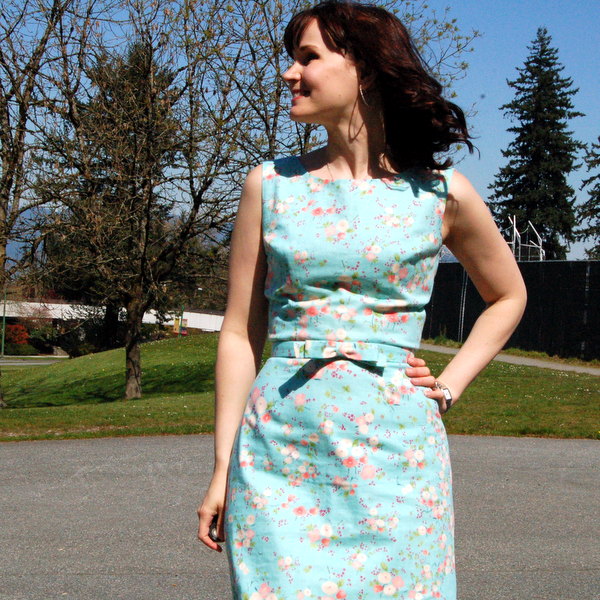Finished just in time for a Sunday brunch with my husband: a McCall's 6551 View C, made up in Nani Iro 2013 Woodblock Pocho! Nani Iro is highly popular with sewists, and rightfully so. Not only are their prints stylish and versatile, the quality of the fabric itself is amazing. Nani Iro is most well-known for their double gauze, a material that feels like sun-warmed clouds with a whisper of spring breeze on your skin. This is my second time working with double gauze and third time with Nani Iro fabrics and I've become a bit obsessed: I want to order hundreds of yards of this stuff and make an entire wardrobe out of it. One minute spent not wearing double-gauze is a minute wasted not living life to the fullest!
The first time I saw double gauze in person I was actually a little underwhelmed. It was thicker and puffier than I had imagined and I had doubts about how well it would drape. But of course my concerns proved to be unfounded, as you can see that, while it is a fabric with a decent amount of body, it still has a nice fluidity to it that is very flattering to the human figure. And of course, wearing this fabric is an experience almost too scrumptious for words!
Here are a couple of projects made with double gauze that other bloggers have shared:
 |
| Simplicity 1882 made up using Nani Iro Waltz, from Did You Make That |
 |
| Vintage pattern made up using Nani Iro Little Letter, from Sewaholic |
I cut this dress in a straight X-Small, which, according to the envelope back, covers sizes 4-6. I usually take a Size 8, but the finished measurements said the X-Small is 36" around the bust, which is quite a lot of ease already, so I figured going one size up might turn out too baggy. As it turns out, it might have worked out better if I had taken Small and done some sort of SBA to reduce the fullness around the bust, because I think a little more room in the shoulders and hips would probably have been good. This is probably how a pattern drafted for B-cup figures should work out for me, though, so I would say it was pretty well drafted and true to the sizing.
One thing that I did have to change about the pattern is the neckline. I cut the pattern exactly as printed for my muslin and the neckline seemed way too big on me and flopped around a lot, almost sliding off my shoulders sometimes, making me wonder if I might need to grade the torso down a bit. But I thought the ease around my bust seemed about right, so I decided to just change the neckline to make it less scooped-out. In my final dress, I bound the neckline with bias but I kept the seam-allowance to make the finished neck-opening smaller all-around, and I reduced the curvature a bit to make the neckline narrower.
This was the first time I used a Microtex (or sharp point) Size 8 needle, and I have to say, the difference is pretty amazing. In combination with a fine polyester thread, Seams come out so nice and smooth, you hardly need to press them! The only non-ideal part of using Microtex needles is that the eye seems to be positioned slightly differently than the typical universal needles, which means the automatic threader on my Baby Lock Elizabeth doesn't work and I have to thread by hand. On the whole, though, I think Microtex needles feel like a pretty good choice for sewing double-gauze.
This pattern was billed as a "1-hour dress" which is pretty fair to say, since it is very simple and easy to put together. However, I spent over 2 days on it! The first day was spent staring at my muslin and agonizing over what needed changing, and then cutting out and muslining two completely different shift dress patterns to see if I liked their fit better (no I never over-react, why do you ask?). The second day, I decided to throw caution to the wind and cut into my "real" fabric with just the neckline alteration, and then spent the majority of my time hand-sewing. I catch-stitched the lining of the sleeves and the bias binding I used on the neckline.
I also hand-basted the sleeves on before machining the armhole hem, even though it wasn't that hard to set in, because I had a bit of a traumatic experience with sleeves. When I was first learning about dressmaking (high-school), I thought everything was totally simple: you just match up the edges and sew it up. Because to a teenager, everything is obvious and simple. Well, my first attempt to put sleeves on a dress brought me down quite a few pegs. My mother was helping me make this dress, and she put in one sleeve, showing me how to do a running stitch in the sleeve seam allowance to help ease it into the armscye. And I promptly ignored her and just stuck the other sleeve in the armscye and clacked away. Three-quarters of the way through the seam, I realized there was a lot more sleeve left than the armscye, and I decided to just squoosh it down and force it to fit. After I finished sewing the seam, I took it out of the machine and looked at my dress: one perfectly set in sleeve on one side, one misshapen wrinkled atrocity on the other. Ever since then, I've been a bit scared of set-in sleeves, and tend to stick to making sleeveless dresses. I'm working on it though! I still treat sleeves with utmost respect, but I hope that with enough practice I won't be scared of them anymore :)


.jpg)